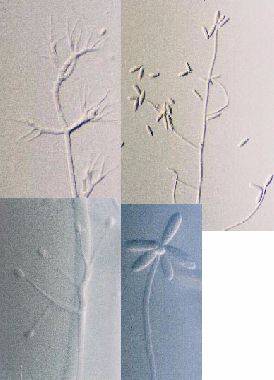
e Fig.1 Cladobotryum longiramosum
|
Cladobotryum longiramosum Castaneda , Fungi Cubense (La Habana): 4 1986. Colonies on MEA, OA, or PDA spreading broadly at 25°C, are floccose, brownish orange (Munsell 10YR7/4-6, Methuen 5C4-6). Exudates are brown (Munsell 10YR4/6, Methuen 6E8). Margin is irregular. Odor is moldy. The reverse is yellowish brown (Munsell 10YR6/6, Methuen 5D6). Hyphae are hyaline, septate, thick-walled, (2.5-)4-8(-11) μm. Conidiophores arise from aerial hyphae, micronematous, septate, thick-walled, branched 2 to 3 times, 5.5-6.5 μm in width, bearing conidiogenous cells intercalarily or terminally. Conidiogenouce cells forming solitary conidia are born at the apex of conidiophores, hyaline, (6-)12-62 x (2-)3.5-5 μm, gradually tapering to narrow irregular apical branches of (0.5-)1.0-1.6 μm wide. Conidiogenouce cells forming cluster of conidia are born solitary, in a verticil of 3 to 4, or laterally from a terminal or intercalary branch of conidiophores. Conidia are hyaline, (0-)1-2 septate, long ellipsoidal to cylindrical with a basal hylum, thin-walled, smooth, (9-)24-29(-34.5) x (5-)6.5-9 μm. Chlamydospores are laterally or terminally on the substrate hyphae, yellowish brown (Munsell 10YR5/8, Methuen 6E8) to borwnish orange (Munsell 10YR7/6, Methuen 5C6), subglobose, (11-)14-22(-28) μm in width, verrucose with warts of (0.5-)1-1.5 μm in diam. Ethymology: variable types of conidia Habitat: parasitic on polypores Specimen examined: on the fruiting bodies of Gloeophyllum sp., collected in Iiyama Kannon, Atsugi, Kanagawa Pref., Japan, on August 13, 1999, by Toshiyuki Tokiwa (Holotype: KPM-NC0009251, Culture KS99083 = JCM 10756 = TAMA 2397) References |
Top